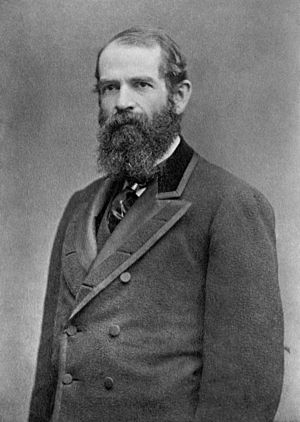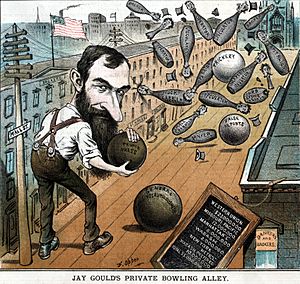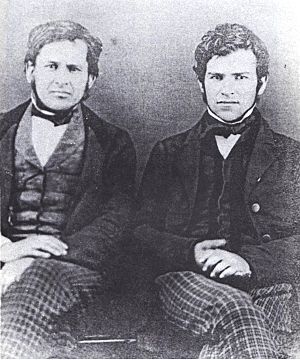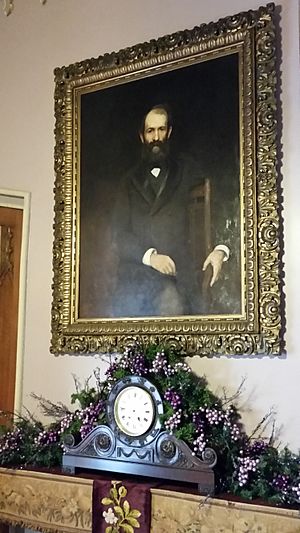Jay Gould facts for kids
Quick facts for kids
Jay Gould
|
|
|---|---|
 |
|
| Born |
Jason Gould
May 27, 1836 Roxbury, New York, U.S.
|
| Died | December 2, 1892 (aged 56) New York City, U.S.
|
| Occupation | Financier |
| Spouse(s) |
Helen Day Miller
(m. 1863; died 1889) |
| Children |
|
| Signature | |
 |
|
Jay Gould (born Jason Gould; May 27, 1836 – December 2, 1892) was a very wealthy American businessman. He became famous for owning and controlling many railroads. People often called him a "robber baron" because of his aggressive business methods. He was one of the richest people in the late 1800s.
Contents
Jay Gould's Early Life
Gould was born in Roxbury, New York. His parents were Mary More and John Burr Gould. His family had a history of business. His great-grandfather, John More, was a Scottish immigrant. He even founded the town of Moresville, New York.
Jay Gould went to Hobart Academy in Hobart, New York. He paid for his schooling by working as a bookkeeper. From a young age, he knew he did not want to be a farmer like his father. So, his father sent him to school with some money and clothes.
First Jobs and Studies
Gould's school principal helped him get a job. He worked as a bookkeeper for a blacksmith. After a year, the blacksmith offered him a share of the business. Jay sold his share to his father in 1854.
Gould then focused on learning more on his own. He studied surveying and mathematics. In 1854, he made maps of the Ulster County, New York area. Two years later, in 1856, he published a book. It was called History of Delaware County, and Border Wars of New York. He had spent several years writing it. While surveying, he also helped finance people who made woodash. This was used in tanning leather.
Starting a Tanning Business
In 1856, Gould partnered with Zadock Pratt. They started a tanning business in Pennsylvania. This area was later named Gouldsboro, Pennsylvania after him. Jay eventually bought out Pratt, who then retired.
Later in 1856, Gould joined with Charles Mortimer Leupp. Leupp was a major leather merchant in the U.S. Their business did well until a financial crisis hit in 1857. This crisis was called the Panic of 1857. Leupp lost all his money. However, Gould used this chance to buy properties at lower prices.

Gould also started an ice business. He harvested ice from the large Gouldsboro lake in winter. This ice was stored in big ice houses. He built a railroad line next to the lake. This allowed him to send ice to New York City in the summer.
After Leupp died, the Gouldsboro Tannery became a problem. Leupp's brother-in-law, David W. Lee, was also a partner. He took control of the tannery by force. He thought Gould had cheated their families. Gould eventually got the tannery back. But he was later forced to sell his shares to Lee's brother.
Jay Gould and Railroads
In 1859, Gould began investing in railroads. He started by buying shares in small railway companies. His father-in-law, Daniel S. Miller, helped him. Miller asked Gould to help save his investment in the Rutland and Washington Railroad. Gould bought shares for a very low price. This gave him control of the company.
He continued to invest in railroad shares during the Civil War. In 1863, he became a manager for the Rensselaer and Saratoga Railroad.
The Erie Railroad Challenges
The Erie Railroad faced money problems in the 1850s. Even with loans from famous financiers like Cornelius Vanderbilt, it struggled. In 1859, it was reorganized as the Erie Railway.
Gould, along with Daniel Drew and James Fisk, got involved. They used clever ways to buy and sell shares. This was known as the Erie War. In 1868, Gould became the president of the Erie Railroad.
Connecting with Tammany Hall
Around this time, Gould and Fisk worked with Tammany Hall. This was a powerful political group in New York City. They made its leader, William M. "Boss" Tweed, a director of the Erie Railroad. In return, Tweed helped them get laws that favored their business.
Gould and Tweed became subjects of political cartoons. These were drawn by Thomas Nast in 1869. Tweed was later arrested for corruption. Gould helped him by providing a large amount of bail money. Tweed was eventually found guilty and died in jail.
The Black Friday Gold Panic
In August 1869, Gould and James Fisk tried to control the gold market. They bought a lot of gold to drive up its price. Gould used his connections to President Ulysses S. Grant's family. He hoped to influence the president.
Their plan led to a financial panic on September 24, 1869. This day became known as Black Friday. The price of gold dropped sharply. Gould made a small profit by selling some gold just before the crash. But he lost it later in lawsuits. This event made people see Gould as a very powerful person. They thought he could control the market. The failed plan caused economic problems for many people.
Expanding Western Railroads

After leaving the Erie Railroad, Gould focused on building railroads in the Midwest and West. In 1873, he took control of the Union Pacific railroad. Its shares were low because of the Panic of 1873. He made it a successful railroad. It relied on shipping goods for farmers and ranchers.
Gould knew every detail of the Union Pacific. He changed its finances and fought its business battles. He also worked on its politics and how it was managed. He helped develop the areas along its tracks.
By 1879, Gould controlled three more important western railroads. This included the Missouri Pacific Railroad. He owned about 10,000 miles (16,000 km) of railway. This was about one-ninth of all the rail in the United States. He also gained control of the Western Union telegraph company. After 1881, he controlled the elevated railways in New York City. By 1882, he controlled 15% of the country's railway tracks.
His railroads made good profits. They could set their own prices. This made Gould much wealthier. In 1883, he stepped away from managing the Union Pacific. This was due to some political issues about its debts. But he made a large profit for himself.
In 1889, he created the Terminal Railroad Association of St. Louis. This company controlled a key point for railroad traffic in St. Louis. After Gould died, the government tried to break up this control.
Jay Gould's Personal Life
Gould was a member of the West Presbyterian Church. He married Helen Day Miller in 1863. They had six children together.
Jay Gould and his son George helped start the American Yacht Club. He owned a steam yacht called the Atalanta (1883).
Gould passed away on December 2, 1892, from a serious illness called tuberculosis. He was buried in the Woodlawn Cemetery in New York. His wealth was estimated at $72 million. He left all of it to his family.
Before he died, Gould helped rebuild the Reformed Church of Roxbury, New York. It is now known as the Jay Gould Memorial Reformed Church. His family's burial place was designed by Francis O'Hara.
Jay Gould's Children
Jay Gould and Helen Day Miller had six children:
- George Jay Gould I (1864–1923)
- Edwin Gould I (1866–1933)
- Helen Gould (1868–1938)
- Howard Gould (1871–1959)
- Anna, Duchess de Talleyrand-Périgord (1875–1961)
- Frank Jay Gould (1877–1956)
See also
 In Spanish: Jay Gould para niños
In Spanish: Jay Gould para niños
- Allegheny Transportation Company
- Gouldsboro, Pennsylvania
- Lyndhurst, his country estate on the Hudson River
- Paragould, Arkansas





